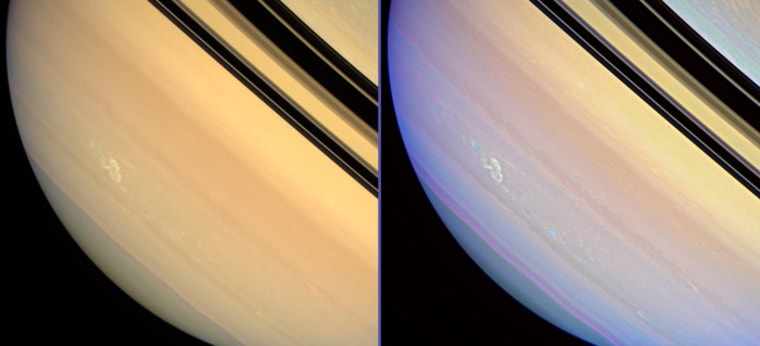A monster storm spawning bolts of lightning 10,000 times more powerful than any seen on Earth is raging on the ringed planet Saturn.
The powerful electrical storm cropped up in Saturn's southern hemisphere five months ago, when it was first spotted by NASA's Cassini spacecraft, and has persevered to become the planet's longest continuously recorded tempest to date.
"We saw similar storms in 2004 and 2006 that each lasted for nearly a month, but this storm is longer-lived by far," said Georg Fischer, an associate with Cassini's radio and plasma wave science team at the University of Iowa, Iowa City, in a statement. "And it appeared after nearly two years during which we did not detect any electrical storm activity from Saturn."
Cassini's radio and plasma wave science instrument first picked up signals from the storm's lightning bursts on Nov. 27, 2007, with the probe's cameras catching their first visual glimpse on Dec. 6. Images of the storm show it as a smudge on Saturn's otherwise creamy cloud bands.
"The electrostatic radio outbursts have waxed and waned in intensity for five months now," Fischer said.
Electrical storms on Saturn are similar to thunderstorms on Earth, but much larger. They can span thousands of miles and generate radio bursts from lightning that can be thousands of times more powerful than Earthly lightning bolts, said mission scientists, who named a massive lightning storm in 2004 "Dragon."
The current electrical tempest is mired in a region of Saturn that mission scientists have dubbed "Storm Alley" because of its frequent and intense storms. Every few seconds the storm belches intense radio pulses consistent with lightning that can be detected even when the weather itself is over the horizon and out of direct view from Cassini.
Researchers hope that by tracking the Saturnian weather, they may gain new insights into the processes behind the planet's lightning, as well as how it changes as the seasons shift from summer to autumn in Saturn's southern hemisphere.
Slideshow 12 photos
Month in Space: January 2014
"In order to see the storm, the imaging cameras have to be looking at the right place at the right time, and whenever our cameras see the storm, the radio outbursts are there," said Ulyana Dyudina, a Cassini imaging team associate at the California Institute of Technology in Pasadena, Calif.
Cassini's onboard instruments have tracked the storm every 10 hours and 40 minutes, when Saturn's rotation brings it into view, though amateur astronomers are also watching over the tempest from Earth.
"Since Cassini's camera cannot track the storm every day, the amateur data are invaluable," said Fischer. "I am in continuous contact with astronomers from around the world."
Launched in 1997, Cassini arrived at Saturn in 2004 and has spotted a series of odd storms while studying the ringed planet and its many moons. The probe has captured views of a hurricane-like storm near the south pole of Saturn and recorded a massive lightning storm about 2,175 miles wide (3,500 kilometers) wide in 2006.
Earlier this year, managers for the international Cassini-Huygens mission, which includes NASA, and the European and Italian space agencies, extended the probe's $3.27 billion expedition by two additional years to 2010.

